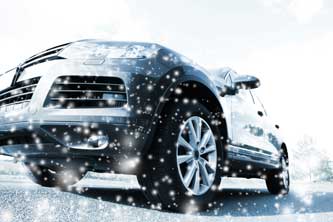 Planning a trip to Canada this winter? Looking forward to exploring this spectacular season behind the wheel of your rental car? Great idea! A winter wonderland awaits!
Planning a trip to Canada this winter? Looking forward to exploring this spectacular season behind the wheel of your rental car? Great idea! A winter wonderland awaits!
However, if this will be your first time driving on snowy roads, we recommend reading the suggestions below. Don't let your adventure end in misadventure!
14 TIPS FOR WINTER DRIVING
1 - Plan ahead. Check the weather and road conditions before setting out. Don't take unnecessary chances. Allow yourself extra travel time or wait for conditions to improve.
2 - Dress comfortably so you don't feel cramped behind the wheel. Bring warm clothing in case you have to get out of the car. Make sure you have gloves or mittens, boots, warm socks and a hat.
3 - Before getting in the car, check the level of windshield washer fluid. The tank should be full of winter windshield washer fluid (to -40 °C freeze protection). You will quickly realize that winter driving in Canada makes for a dirty windshield; you will be using your windshield wipers often. Running out of windshield washer fluid will greatly reduce visibility, affecting your own safety and the safety of others. Our best advice is to keep an extra gallon of windshield washer fluid in the trunk of your car.
4 - After starting the car, turn on the heat at "defrost". This will keep the windows from fogging up. Remove the snow and ice from the windows, headlights, rear-view mirrors and roof of the car. Every rental car should come with a snow brush and ice scraper. Wait for the windows to be completely clear before setting out.
5 - Keep the fuel tank as full as possible. While it is never fun to run out of gas, it's much worse in winter!
6 - Turn on your lights when visibility is bad.
7 - Be alert, slow down and stay in control of your vehicle. Leave sufficient braking distance between you and the vehicle in front. Tires have less traction on wet or snowy roads, so it takes longer to stop.
8 - Beware of black ice. Sometimes we have the impression that the road surface is dry, when it may in fact be covered with a slick and subtle layer of ice, almost invisible to the naked eye. While this is not always the case, driving as though the road is covered in ice will help you to adopt safe driving habits.
9 - Never brake suddenly. If you have to stop quickly, pump the brakes rather than slamming them on. Slow down as you approach a curve rather than braking in the middle of it, which could cause you to lose control of your vehicle.
10 - Remember what to do if your vehicle starts to skid. Take your foot off the accelerator in order to slow down and regain control of your vehicle. Look in the direction you want to go, and turn the wheel in the same direction.
11 - Look far ahead as you drive so you can recognize hazards and give yourself time to react. Slow down: this will help to avoid the need to change direction, brake or accelerate quickly. Sudden movements can cause you to skid. Be particularly careful on highway overpasses, which tend to freeze more quickly and stay frozen longer than the rest of the highway. Keep an eye out for "black ice", shiny black patches on the roadway.
12 - Remain inside your vehicle if you are stuck. Use your hazard lights to attract attention to your vehicle. If you must get out of the vehicle, use the door the farthest from passing traffic. Don't keep the engine running more than necessary: beware of exhaust fumes and crack open a window to let in some fresh air.
13 - If you need to make a call with your mobile phone, pull off the road and stop the vehicle. Remember that it is illegal in Canada to talk on the phone while driving.
14 - If you will be driving in Quebec, note that Quebec law requires all road vehicles to be equipped with winter tires from December 1st until March 15th.
15 - Since October 1st, 2024, British Columbia has required the use of winter tires from October 1st to March 31st (and until April 30th in some areas) on most highways, mountain roads, and rural roads in heavy snowfall areas.
FAQ
- How do I reserve my car rental?
- When should I reserve my car rental?
- Can I cancel my car rental reservation for free?
- Car rental search engine
- Ideas for self-drive road trips in Canada
- What type of driver's license do I need in Canada?
- What is the price of gas in Canada?
- The Canadian Highway Code
- Do I need a child's car seat?
- How old do I need to be to rent a car?
- Extra charges and options available at the rental office
- 14 tips for winter driving
- Best Price Guarantee
- Practical information for travelling in Canada
- Travel guide to Eastern Canada
- Travel guide to Western Canada











